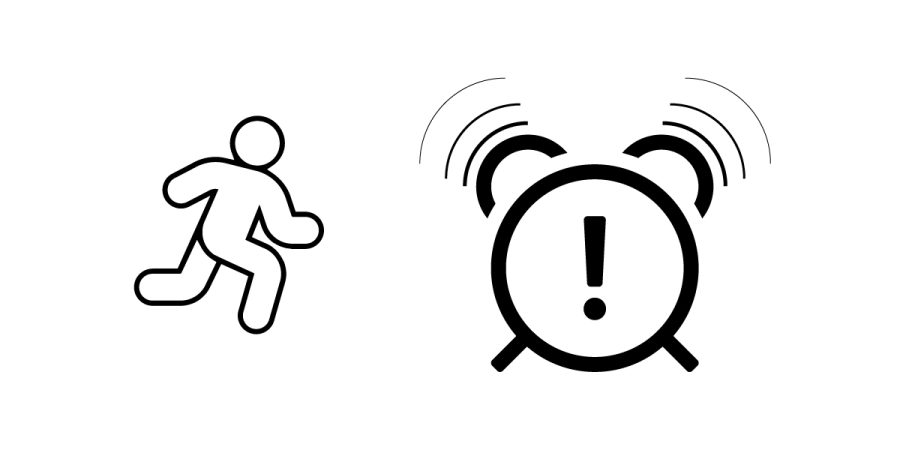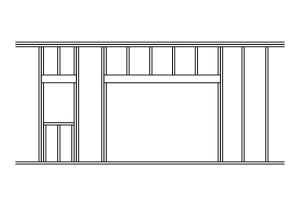Communication Systems
LAN vs WAN Networks
LAN System: Local Area Network
WAN System: Wide Area Network
- Allows data sharing on a non-public computer
- The Internet is an example of a WAN
A Local Area Network (LAN) establishes connections between devices within a confined geographical area, such as a residence or workplace. Conversely, a Wide Area Network (WAN) facilitates connectivity among devices spanning broader geographical regions, encompassing cities, nations, and even the entire globe.
Terminal Room: Generally in a larger building, where the main utilities (telephone, cable, electrical, etc) enter the structure. There may be multiple rooms depending on requirements or codes, and local utilities will have their own requirements.
- They are split into riser cables located in Riser Shafts
- Generally located near the core, where they travel vertically and then enter the equipment rooms or closets at each level.
Riser Closets | Apparatus Closets: Riser shafts provide space for cabling to serve each floor’s rooms.
Building Automation Systems (BAS)
Is a computer based integrated system used to monitor and control systems. These systems typically include: HVAC, energy management, lighting, life safety, and security. Other systems sometimes included: Vertical transportation, communications, material handling, and landscape irrigation.
- BAS Reduces energy costs through better systems management, allowing for the monitoring of complex buildings and reducing the number of people needed to service/manage a building.
- BAS can also notify the authorities in case something bad happens (fire, security)
- Energy Management System (EMS): Part of a BAS. An EMS will monitor energy and systems, control the equipment and help them run more efficiently to use the energy better.
- Nest and programmable thermostats are a localized form of BAS.
Security Systems (Notifications)
Security systems include everything and anything for detecting intruders, preventing entry, controlling access to secure areas, and notifying the authorities in the event of unauthorized entry or other emergencies. The type of security depends on the level of protection required and the level of threat expected.
1. Intrusion Detection Alarm & Notifications
Intrusion is detected when a notification system triggers an alarm signal. Typical alarms are audible: horn/siren, turn on lights, alert an attendant at a central control station, or be relayed to a central security service.
- If a tenant leases a space, generally the alarm will be signalled to the main central station (typically the lobby).
- When an alarm is signaled, its recorded in the system
- In rare use cases, they may not be visible or audible. (silent alarms)
2. Perimeter Protection / Security (Entry Points)
Perimeter Protection
Motion sensors and other types sense people at the perimeter of a building or property before or while they are trying to get into the space.
- Notes: Sound and motion sensors don’t make much sense on the exterior of a building because they could potentially be constantly sending false positives.
- Many times it will turn on a light to illuminate the area to expose any activity and draw attention to the space.
Security (Entry Points)
At openings on the building, especially from the exterior can be weak points, such as windows, doors, and skylights. One of the most secure applications is done by Magnetic Contacts as they are rather small and can be concealed easily.
Photoelectric Cell Sensors: Placed on windows and doors, passes a beam of light between them and sends a notification if it’s broken.
Magnetic Contacts: Used on doors and windows to send a signal once broken.
- May be surface mounted, recessed into the door and frame, or concealed in special hinges.
Glass Break Detectors: Sense when a window has been broken or cut. Use either metallic foil or a small vibration detector mounted on the glass
Window Screens: Fine wires are embedded can set off alarms when cut or broken
Photoelectric Cells: Detect when an emitted beam of electrons has been broken. Either by person or opening.
- Can be surface mounted or recessed into the frame.
3. Area/Room Protection
This has overlap with the windows and doors from the last section, but is more specific to sensing when someone is in a room or space that they should not be in.
Pressure Sensors: Detects weight. Under floor and will let you know when someone is in a space
- Can be placed in mats, or integrated into the building design like under carpets or other materials.
Ultrasonic: High frequency sound wave to detect intruders. When the waves are interrupted, alarm signal is activated. These can cover spaces as large as 50 to 200 feet.
Photoelectric Beams: Uses a beam to send across a space. If the beam is broken, the device sounds an alarm. These can be focused into a large or small area.
Infrared Detectors: Sense sources of infrared radiation, such as the human body that exceed the normal rooms radiation (heat) levels.
- Unobtrusive, but needs a clear field of vision of the overall room.
Audio Protection: Triggered by unusual noise. When the normal level of noise is exceeded, an alarm is sounded.
Microwave Detectors: Emit microwave radiation and sense interruptions in the radiation field.
- Rarely used because they can penetrate a lot of building materials and bounce off metals and are unreliable. There generally are better approaches.
4. Object Protection
Great for use with things like safes, artwork, file cabinets, and other equipment. Only used in specialty situations like museums, heads of states, and alike.
Capacitance Proximity Detectors: Sense touch on metal objects.
Vibration Detectors: Sense a disturbance of an object
Infrared Motion Detectors: Can determine if the space around an object is violated.
Access Control (Locks)
Access Control: Limits and restricts access to secure areas. The simplest access control is the mechanical lock.
- The problem with mechanical locks is that duplicate keys can always be made. Despite how complex locks are, they generally always have a way to be cracked. In general most access control should be thought of as a ‘deterrant’ and not expected to last forever during break in attempts.
- Any time an automated lock is mounted on a door that is a part of the Means Of Egress, it must always open in the direction of egress at all times and be opened without any special equipment or knowledge.
Electronic Hardware (Electronic Locks)
Electronic locks provide a wider range of ability to provide security, while also monitoring who entered and exited a space. They allow the ability to program different access codes as well as different times of access. This includes equipment that monitors door openings using electric or electromagnetic ways.
Generally, in all cases, the door handle from the secure side will unlock the door.
- Electric Lock: Upon activation: Retracts the bolt from the secure side of the door.
- The lock can be opened mechanically as normal, or digitally by pressing a button or switch.
- Electric locks can be battery powered, or they need an electric hinge or other power transfer device to carry the low voltage wiring from the control device to the door and then the lock.
- In some cases, it’s set to open and unlock in case of a power failure. For some battery operated ones, you may need another battery to provide temporary power to access if its remained lock during battery failure. This spare battery should be accessible somewhere from the outside.
- Electric Latch: Variation of the electric lock. Similar to the lock, but a latch. All the power is provided via the door jamb, whereas the electric lock needs to provide electricity to the door as well.
- Electric Bolts: Are separated from the operating hardware of a door. They can be mounted in the strike jamb or head of a door.
- Electric bolts are generally not allowed on exit doors because there is no sure way to mechanically open the door if the bolt does not retract.
- Keycard Readers | Key Fob Readers: Devices that can read a magnetic code on a small plastic card or fob when it is inserted into the reader or within a certain distance of the reader.
- There is the ability for the card reader to submit the times and activation to a computer to monitor activity. It can also restrict access during certain times a day. Many times the card reader is embedded into the hardware device itself (like a card reader for hotels)
- If a card is lost or stolen, it can easily be turned off and deactivated, with a new one providing access.
- Keypad: Alternative to the keycard readers. Programmed with a code that will allow access or entry. There is a set of numbers or symbols on the keypad that the user can activate.
- Eliminates the control problem of duplicate keys, however, they do not offer the same programmed flexibility.
- Typically, they are not connected to a central control station so they may not provide the ability to track or monitor individuals.
- Magnetic Hold-Open Device: Activated by a smoke detector, the device holds a door open and then closes automatically in case of fire. This can be activated by a smoke detector, power failure, or central alarm signal.
- Common in long corridor situations where doors should remain open for easy access, like in hospitals.
- Electromagnetic Lock: When activated, the lock holds the door closed with a powerful magnetic force.
- Card readers, keypads, buttons, or other devices deactivate the electromagnet
- Can be designed to unlock upon fire alarm, power failure, etc.
- Biometric Device: Can recognize voice or a biological feature such as the retina of an eye, or a fingerprint.
- These provide almost counterfeit-proof methods of identification.
- These devices are expensive, but may be worth the cost for a very high level of security.
- Phone & Digital Locks
- Locks can be programmed to be accessed from phones, including phone apps. For example hotels can have a ‘hotel app’ which provides access to the room.
- This provides a great level of control and allows reducing need for hardware, keys, etc.
- Check-ins for hotels can be contactless now, as access is provided via app.
Site Security Overall
Site Security: Involves protecting a building or group of buildings from a variety of threats, anything from vandalism to vehicular bomb attacks.
The first step of site security is to determine the types of risk and amounts of protection needed. This should be done with consultation of the client, experts, and in some cases (governmental) with other agencies. Once this is determined, it will then drive the overall goals and objectives.
- The AIA takes the stance that site security’s visual impact should be minimized so that the facility doesn’t appear like a fortress. Regardless of the aesthetic intent of the design, it’s important to balance the security with accessibility and the functional needs of a building.
Sally Port (Check Gate)
One gate is opened and then closed once the car is admitted to the area. The car is then checked and inspected prior to admission. If they are cleared for entrance, the inner gate is opened and the car is allowed to go inside.
- Prevents unauthorized people from entering and also stops people following closely behind another who is authorized to enter.
- Essentially like a water-lock.
- In residential applications the check and inspection is less of an issue, and more for security control.
Blast Design
Buildings that can focus or amplify blast energy should be avoided, this includes L or U shaped buildings where a blast inside the wings would reverberate and affect more of the building.
- Avoid buildings with reentrant corners (inside corners) and second floor overhangs.
- Injury can be minimized by using laminated glass.
- Blast energy decreases in inverse proportion to the cube of the distance
Stand-Off: Distance between a building and the potential location of a blast threat.
- The best way to prevent blast damage from happening is to increase the stand-off distance. This can be done with landscaping, hardscaping, and items like bollards. Access control to the building is imperative.
Protection from Outside Towards Inside
With most designed systems, there are passive (low) and active (high) implementation options. With security, it’s no different, however, high and low security options become less available to you as you get further inside the building, without causing hardship or extreme cost for the programmed functions.
For example, you can have a manned guard booth outside at the entries, but it’s much more difficult to have one inside a hallway. This is possible, think of prisons and detention centers, but the cost is a burden and only accepted in rare cases based on the needs of the program.
1. Perimeter Control
The first line of defense at a site. Generally is a physical barrier that discourages or prevents unauthorized people or vehicles from entering the site or getting close to the building.
| Low Security Example | High Security Example |
| Could be something as simple as a fence. – Fences are generally better at keeping people out (rather than cars) – A variety of fences are available, transparent to solid. If solid is used, it should be planned to eliminate concealed areas. – When used with motion detectors, cameras and other security devices, they are quite effective. | Holding unauthorized vehicles at a distance from the building. – Sally Port – Stand-off distances increased (gates) |
2. Access & Parking
All of the car access to a site and the parking structures, garages, etc. on a site. Vehicles pose a significant threat to buildings based on their ability to house destructive items securely, as well as many parking structures being located within footprints of buildings.
| Low Security Example | High Security Example |
| – Limiting access points to a site – Using gates and Card readers – Incorporating camera surveillance | – Guard booths (manned) – Retractable bollards and other retractable devices – Heavy duty gates / sally ports |
3. On-Site Security
On facilities where the outdoor area is used for purposes such as eating, recreation, relaxing, etc… Many of the amenities and elements in the space can be ‘hardened’ to provide protection without drawing attention to them.
- Hardened meaning items like a concrete bench with reinforcement or footings, instead of a wood bench
| Examples | |
| – Hardened signs, fountains, benches, bicycle racks, lighting poles, low walls, retaining walls, etc. |
4. Building Envelope Protection
The final layer of protection for a building and its elements, the exterior envelope of a building can be designed to prevent forced entry and resist damage by explosions. This need must be balanced with the appeal to not make the building appear as a fortress.
| Examples | |
| – Solid walls can be designed to encompass the building and provide protection. – Building entrances and egresses should be easy to use and accessible for building personnel as well as visitors. In some cases, entrances for authorized building persons should be separated from visitor entrances. Access should be controlled from the general public. – Lighting and camera surveillance should be planned at the building line to provide the needed coverage while being protected from weather and vandalism. – Air intakes and HVAC equipment may need to be separated from access to the building or protected in another way in order to prevent the introduction of chemical or biological materials. – Materials can be hardened like masonry or metals, limiting glazing and softer materials. Reinforcement can increase within the depth of the assembly as well. |






Leave a Reply
You must be logged in to post a comment.